Imagine overcoming writer’s block and crafting compelling narratives with ease. Sudowrite, an AI writing assistant, is making this a reality for story writers everywhere. With an array of features designed to enhance your writing style and even aid in composing poetry, this tool revolutionizes creative writing. In this Sudowrite review article, we’ll delve into some standout features of the tool and explore some of its good alternatives. So, if you’re an author looking to elevate your storytelling, keep reading – Sudowrite might be the game-changer you need.
Using Sudowrite
Examples of different genre stories generated by Sudowrite
Philosophical fiction
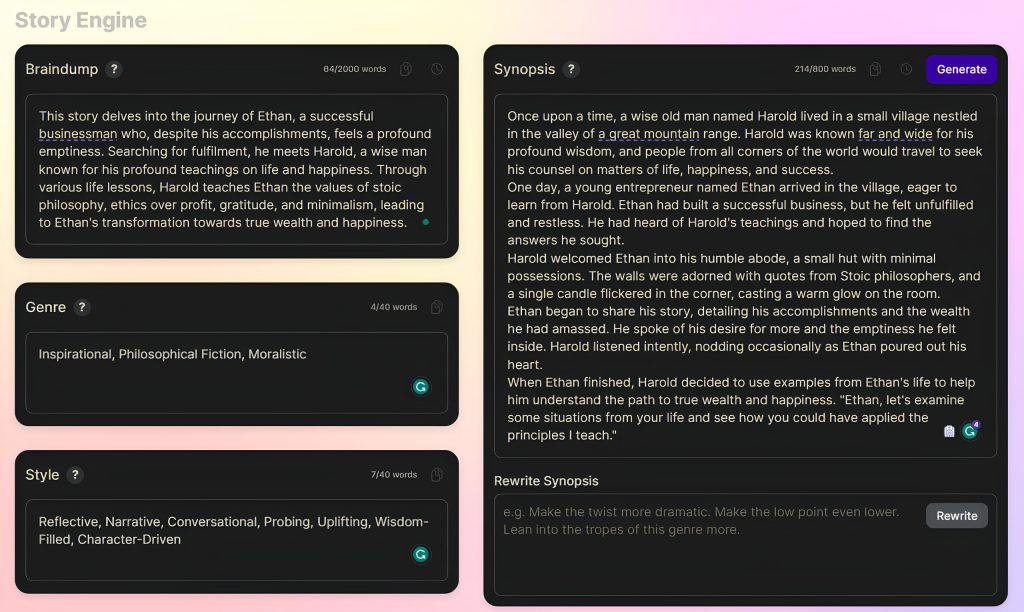
(To draft this story, I used the story engine feature and refined the draft multiple times)
Title: Seeking True Wealth
Once upon a time, a wise old man named Harold lived in a small village nestled in the valley of a great mountain range. Harold was known far and wide for his profound wisdom, and people from all corners of the world would travel to seek his counsel on matters of life, happiness, and success.
One day, a young entrepreneur named Ethan arrived in the village, eager to learn from Harold. Ethan had built a successful business, but he felt unfulfilled and restless. He had heard of Harold’s teachings and hoped to find the answers he sought.
Harold welcomed Ethan into his humble abode, a small hut with minimal possessions. The walls were adorned with quotes from Stoic philosophers, and a single candle flickered in the corner, casting a warm glow on the room.
Ethan began to share his story, detailing his accomplishments and the wealth he had amassed. He spoke of his desire for more and the emptiness he felt inside. Harold listened intently, nodding occasionally as Ethan poured out his heart.
When Ethan finished, Harold decided to use examples from Ethan’s life to help him understand the path to true wealth and happiness. “Ethan, let’s examine some situations from your life and see how you could have applied the principles I teach.”
Harold asked Ethan about a time when he faced a difficult decision in his business. Ethan shared a story about choosing between two suppliers, one offering lower prices but questionable ethics and the other with higher prices but a solid commitment to fair labor practices.
Harold nodded and said, “Focusing on principles over tactics would have guided you to pick a supplier with ethical practices. Prioritizing long-term thinking and ethical decision-making leads to true wealth and happiness.”
Next, Harold inquired about a challenging situation Ethan had faced in his personal life. Ethan recounted a story of a close friend betraying his trust, which left him feeling hurt and angry.
Harold gently explained, “By embracing Stoic philosophy, you could have reminded yourself that you cannot control the actions of others, only your reactions to them. Cultivating inner peace and resilience through mindfulness and meditation would have helped you navigate this difficult situation gracefully.”
Harold then asked Ethan about his material possessions and how they contributed to his happiness. Ethan admitted that despite owning many things, he still felt unfulfilled.
Harold suggested, “You can find greater happiness by practicing minimalism and focusing on experiences over possessions. True happiness comes from living a life of purpose and meaning, not from accumulating material wealth.”
Finally, Harold asked Ethan to reflect on the blessings in his life. Ethan thought for a moment and began to list the many opportunities and privileges he had been given.
Harold smiled and said, “Cultivating gratitude for these blessings will bring you peace and contentment. Remember to be humble and grateful for all that you have.”
Ethan thanked Harold for helping him see his life from a new perspective and vowed to apply these teachings to his own life. He felt a newfound sense of purpose and direction as he left the village.
Over time, Ethan transformed his life, embracing the principles Harold had shared. He became a beacon of inspiration to others, sharing his journey and the wisdom he had gained. And in doing so, Ethan discovered the true wealth he had been seeking all along.
Horror
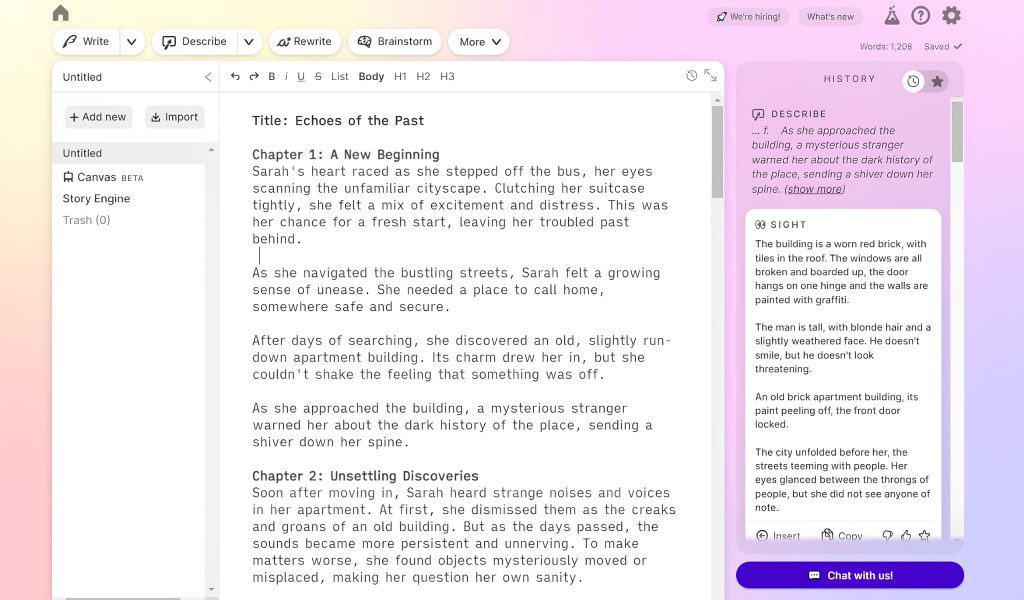
(To generate this story, I used most of the features that Sudowrite has to offer)
Title: Echoes of the Past
Chapter 1: A New Beginning
Sarah’s heart raced as she stepped off the bus, her eyes scanning the unfamiliar cityscape. Clutching her suitcase tightly, she felt a mix of excitement and distress. This was her chance for a fresh start, leaving her troubled past behind.
As she navigated the bustling streets, Sarah felt a growing sense of unease. She needed a place to call home, somewhere safe and secure.
After days of searching, she discovered an old, slightly run-down apartment building. Its charm drew her in, but she couldn’t shake the feeling that something was off.
As she approached the building, a mysterious stranger warned her about the dark history of the place, sending a shiver down her spine.
Chapter 2: Unsettling Discoveries
Soon after moving in, Sarah heard strange noises and voices in her apartment. At first, she dismissed them as the creaks and groans of an old building. But as the days passed, the sounds became more persistent and unnerving. To make matters worse, she found objects mysteriously moved or misplaced, making her question her own sanity.
Determined to uncover the truth, Sarah started investigating the strange occurrences. She found clues about the building’s past and previous tenants, each more chilling than the last. As she pieced together the puzzle, she felt an unseen presence watching her.
Chapter 3: The Neighbors
During her investigation, Sarah befriended Lucy, a quirky neighbor who relieved her with her eccentric personality and humorous anecdotes about the other tenants, including Mr. Thompson. Lucy’s lighthearted banter helped Sarah cope with her growing anxiety.
Lucy was a freelance artist who had moved into the building a few years ago, seeking inspiration for her dark and surreal paintings. She had a penchant for wearing mismatched socks and always seemed to know the latest gossip about everyone in the building.
As they grew closer, Lucy revealed that she, too, had experienced strange events in the building, bonding them over their shared experiences. However, there were moments when Sarah couldn’t quite recall how or when she had first met Lucy.
Mr. Thompson was an elderly man with a stooped posture and a mysterious past. He lived a reclusive life in the apartment next to Sarah’s. He was rarely seen outside his apartment, and when he did venture out, he always wore a long, dark coat and a wide-brimmed hat that obscured his face. Sarah couldn’t help but notice that no one else in the building seemed to interact with him,
However, Sarah’s anxiety medication caused her to experience vivid nightmares and hallucinations, making it difficult to distinguish between reality and her imagination. The line between the two blurred, and Sarah’s grip on reality began to slip.
One night, as she lay in bed, she heard a chilling whisper in her ear, but when she turned to look, no one was there.
Chapter 4: The Descent
As the story progressed, the terror intensified. Sarah became increasingly paranoid and isolated as she delved deeper into the building’s dark secrets. A growing suspicion that Mr. Thompson was somehow involved in the building’s past added a sense of urgency and danger to her investigation.
One day, she discovered a hidden room behind a bookshelf in her apartment. Inside, she found a tattered journal filled with cryptic entries and disturbing illustrations. Her investigation led her to uncover the tragic stories of the building’s previous tenants – tales of madness, betrayal, and unspeakable horrors. Each revelation shook Sarah to her core, and she began to question her own perceptions.
As she read the final entry in the journal, she felt a cold hand on her shoulder, but when she spun around, the room was empty.
Chapter 5: The Vanishings
As Sarah’s grip on reality continued to slip, she became more and more desperate to find answers. She spent sleepless nights poring over the tattered journal, trying to decipher its cryptic entries. The line between reality and her imagination blurred even further, and she began to see ghostly figures lurking in the shadows of the apartment building.
One evening, after a particularly vivid nightmare, Sarah awoke to find the journal open on her bedside table. The pages were flipped to a passage she hadn’t read before, describing a hidden room in the building where the spirits of the tormented tenants were said to be trapped. The passage hinted that the key to freeing the spirits and restoring her sanity lay within that room.
Determined to confront her fears and find the truth, Sarah followed the journal’s clues, which led her to Mr. Thompson’s apartment. She hesitated for a moment, then knocked on his door. When there was no answer, she cautiously pushed the door open, only to find the apartment empty and abandoned. She quickly ran down to Lucy’s apartment to tell her about her findings and the disappearance of Mr. Thompson but found no one there too.
Thinking of this as a coincidence, she returned to her own room and started waiting for Lucy, but she was visibly tired from all the hassle and instantly dozed off. The Next day, she went to see Lucy again and knocked. Lucy didn’t open the door again. Sarah decided to open her door anyway with the spare key she had. To her dismay, no one was there. Worried, Sarah instantly called the police to tell them that her only friend had gone missing.
Chapter 6: The Unseen
The confused policeman from the other side of the phone asked her address again and, after confirming, asked her if she was sober. He said this building had been vacant for the last 25 years, after one night when all the tenants were poisoned to death. The police haven’t yet found the killer.
Sarah hung up the phone, her hand trembling. She was overcome with a nauseating wave of confusion and dread. She was sure she’d met Lucy, had heard her laughter, and seen her expressive, unconventional paintings. And Mr. Thompson, with his long coat and wide-brimmed hat, wasn’t a figment of her imagination, was he?
But the cold, hard truth was undeniable – the building had been vacant for 25 years. Was it her paranoia? Was her medication causing her to lose her grip on reality entirely? The thought made her breath hitch in her throat.
As she turned to leave, she noticed a hidden door, slightly ajar, revealing a dimly lit staircase leading into darkness. With a deep breath, Sarah descended the stairs, her heart pounding in her chest, unsure of what she would find at the bottom.
Chapter 7: The Edge
The story continued with a confusing scene. Sarah stood on the edge of the 30th-floor terrace, questioning whether her experiences were real or just her imagination.
The wind whipped around her, threatening to pull her into the abyss below. As she teetered on the edge, Sarah’s mind raced with memories of her past – the pain, the heartache, and the darkness that had haunted her for so long. She knew she had to choose to face her demons head-on or let them consume her once and for all.
Just as she was about to decide, a chilling voice whispered her name, leaving her to wonder if she would ever truly be free.
Benefits and drawbacks of using Sudowrite
Benefits
- Non-stop creativity: Sudowrite’s brainstorming feature had my back during my 2am writing bouts.
- Dynamic editing: The Rewrite feature saved me from getting stuck in the cycle of rewriting the same sentence repeatedly.
- Personalized expansion: With the Expand feature, my scenes never felt rushed anymore.
- Visualization: It helped me better visualize my characters and world better with AI art generated from my descriptions.
Drawbacks
- Autocomplete Limitations: While Sudowrite’s ‘Write’ feature was impressive, it occasionally lacked narrative intuition. It sometimes disrupted the natural flow of my story with ill-fitting suggestions.
- Limited Customization: Though Sudowrite proves to be a steadfast writing ally, it struggles with style and tone customization. It occasionally resulted in an inconsistent flow of my stories.
Nonetheless, I found it incredibly supportive as is.
Sudowrite Review: Comparison and Pricing
How is it?
I have loved using Sudowrite and can attest to its effectiveness in boosting creativity. The tool is intuitive, and its unique features like brainstorming, ‘Show not Tell,’ plot expansion, and AI feedback made me overcome writer’s block. Sudowrite has significantly helped me craft complex narratives and develop engaging content effortlessly. However, a missing plagiarism checker makes it essential to verify originality independently.
If I have to, I will score Sudowrite a 4.2 out of 5. While I am in awe of its capabilities to generate storylines, expand plots, and provide immediate feedback, there’s room for improvement. Yet, the robust creativity enhancement it offers and its convenience to use remain unparalleled, making it an invaluable tool for any writer.
Features of Sudowrite
Canvas

I found the Canvas feature to be a game-changer. It gave me an AI canvas to explore plot points, character arcs, and themes, and it even generated alternate plot twists with me. It’s like having a co-writer who never runs out of creative fuel.
Brainstorm
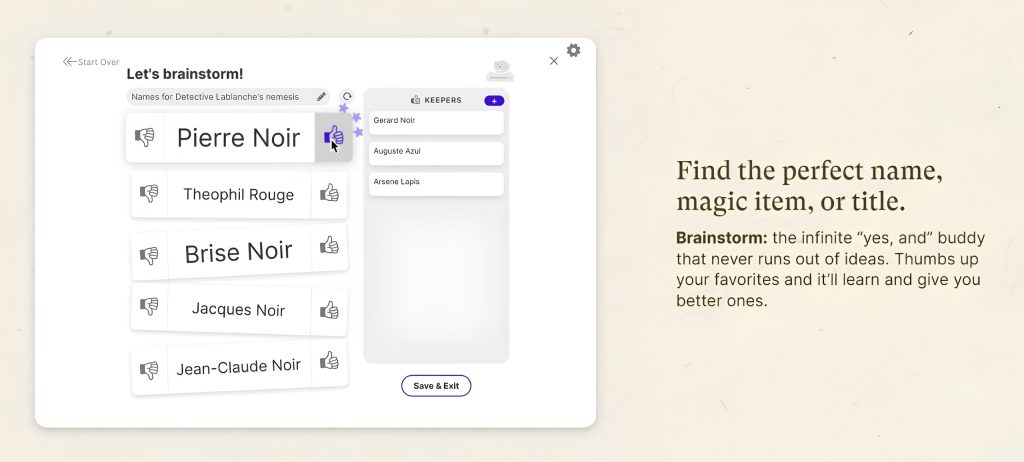
This Brainstorming tool is the ultimate “yes, and…” buddy. It always had ideas, and I could thumb up my favorites. Over time, it learned my preferences and consistently offered even better suggestions, making itself an invaluable part of my writing process.
Describe

With the Describe, describing sight, smell, touch, sound, taste, and metaphor attributes of an otherwise flat-looking scene becomes easier.
Write

The Write feature was my silent collaborator. During those periods when words seemed elusive, Write stepped in, generating text that mimicked my style. It did not merely spew words; it mirrored my voice, understanding the nuances of my characters, tone, and plot. It truly felt like I had a partner who grasped my vision.
Visualize
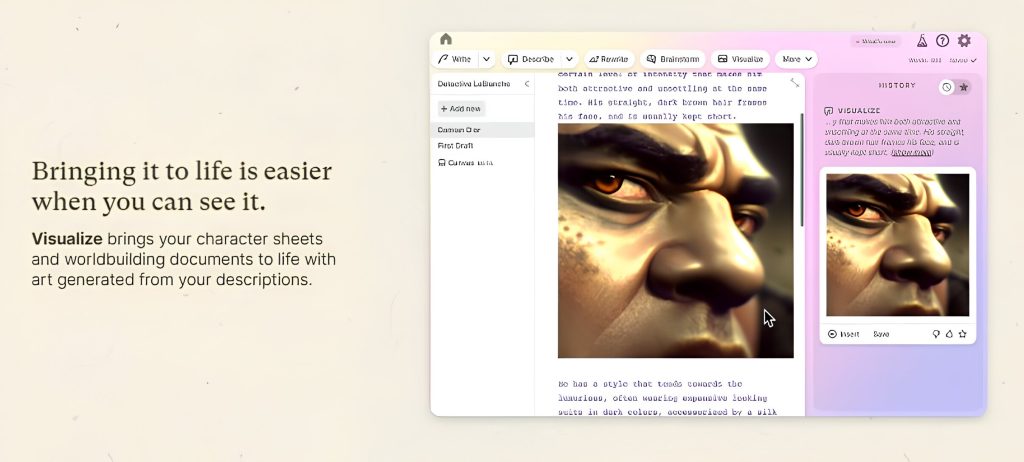
Visualize lent shape and color to my imagination. It translated my simple character descriptions into tangible, AI-generated art, making my characters and worlds come alive in an unforgettable manner. It was an exhilarating process that infused vibrancy into my stories.
Rewrite
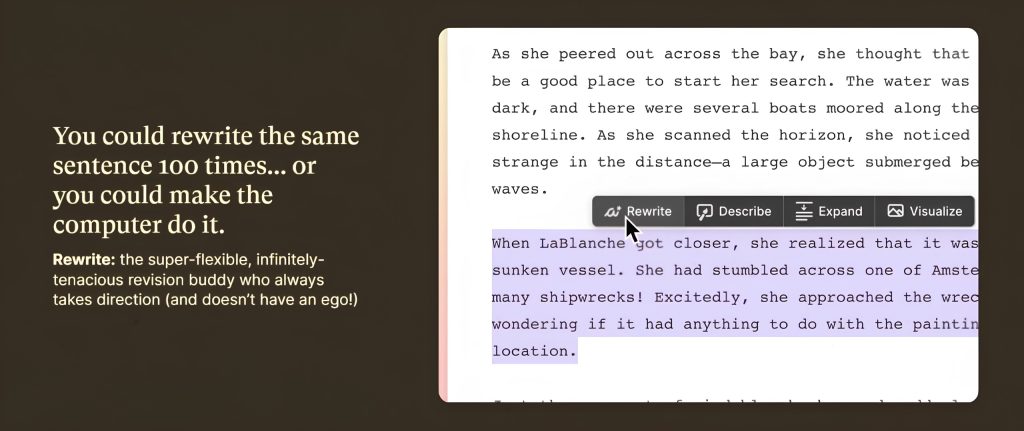
Editing is made infinitely easier with the Rewrite. It’s like having a tenacious revision buddy who rewrites sentences for me, never tires, and takes every direction without any ego. My drafts have never been so polished!
Expand

Using Expand felt like wielding a magic wand. It impeccably addressed pacing issues in my stories, fleshing out scenes that seemed too abrupt or rushed. It ensured the narrative rhythm remained unhindered, and my readers stayed immersed in the journey. It was akin to having an expert editor smoothing out the kinks in my drafts.
Pricing plans and Free Trial options
I really liked Sudowrite’s pricing. They have plans for different needs, which offer flexibility and affordability. The “Hobby & Student” plan starts from $19 a month for 30K words and goes over to the “Max” plan at $129 a month for 300K words. They even offer a risk-free trial and a simple cancellation process which I appreciated. The easy access to customer support was a bonus. If you’re struggling with your writing, Sudowrite could be the game-changer you need.
Sudowrite Alternatives
OpenAI’s Playground

OpenAI’s Playground is a powerful tool for generating ideas, drafting content, and even writing dialogues. It’s been instrumental in overcoming writer’s block and adding depth to my narratives. But it’s not without challenges; the token limit can be restrictive and sometimes misses the finer nuances of storytelling. Sudowrite, on the other hand, is specialized in story generation. The Playground offers more flexibility to experiment, while Sudowrite is comparatively easier to use.
Both have unique strengths, but for someone pro at interacting with AI models, OpenAI’s Playground can produce better results.
Forefront.ai

Forefront.ai is an exciting tool. It is currently free and surely does provide a better ChatGPT Experience. It has pre-built personas of various famous personalities, including world-renowned authors/writers, and it also enables you to add a custom persona. Imagine your favorite writer generating your story’s first draft using the powers of GPT-4.
It’s a fantastic tool to play with. However, it lacks the customization & professional fiction writing features that Sudowrite offers.
Jasper.ai

As someone who has used both Jasper.ai and Sudowrite, I can say both have unique advantages. Jasper.ai has been invaluable for idea generation, character development, and dialogue creation. However, it can sometimes overcomplicate narratives. Sudowrite, on the other hand, is built specifically for fiction and excels in plot and character idea generation. However, its application is less versatile than Jasper.ai, limiting its use beyond fiction writing.
Final Thoughts and Recommendations
Overall Evaluation of Sudowrite
Overall, Sudowrite is an impressive tool that truly revolutionizes the writing process. It’s not just an aid but a co-creator, enabling writers to surpass creative boundaries. However, it does have minor drawbacks, such as potential plagiarism concerns and the lurking risk of dependency. However, its benefits greatly outweigh these issues. I have found it to be a game-changer in my writing journey, and so will you.
Recommendations for writers and authors
For authors and writers looking to enhance their storytelling skills, Sudowrite is a must-try tool. It can assist you in crafting a compelling narrative to developing complex characters. However, it’s essential to use it responsibly to ensure that your unique voice as a writer is not overshadowed. Also, regularly check for plagiarism while using it to ensure the originality of your work.
Future developments and improvements for Sudowrite
Enthusiasm surrounds Sudowrite’s future plans for enhancement and expansion. Users are particularly keen on improving text generation accuracy and fluency and expanding the creative text formats it can generate – including poems, stories, and scripts. A more intuitive, user-friendly interface is also highly anticipated. The aspiration for Sudowrite to generate content in various languages could open the platform to a global audience. Additionally, potential integration with other writing tools, platforms, and features that provide feedback on writing style and grammar could elevate the writing process.
Sudowrite’s trajectory suggests a commitment to meet these user expectations, promising to deliver a fantastic AI-assisted writing tool.
Conclusion
To conclude, Sudowrite has proven to be a valuable assistant in brainstorming, refining drafts, and expanding plotlines. It’s a cost-effective, efficient solution for writers seeking to elevate their storytelling prowess. However, it’s essential to remember that while it is a powerful tool, nothing can replace a person’s original, unique voice. It is an aid, not a crutch.
Have you tried Sudowrite or any other AI writing assistant? Do you have any questions about my experience with it? Let’s continue this discussion in the comments below.